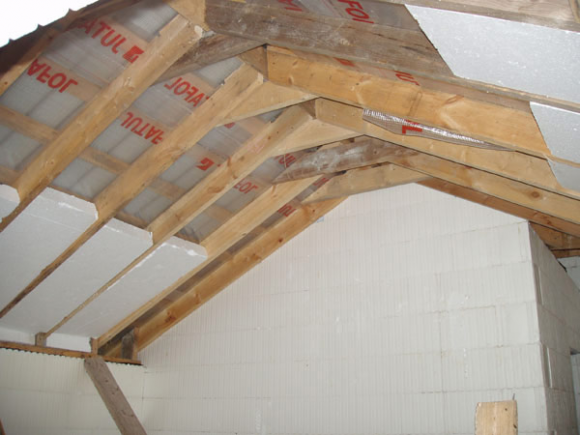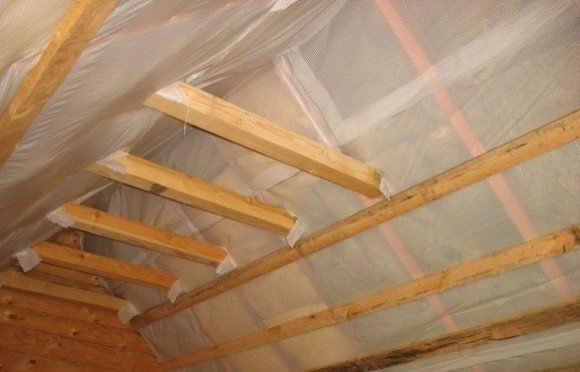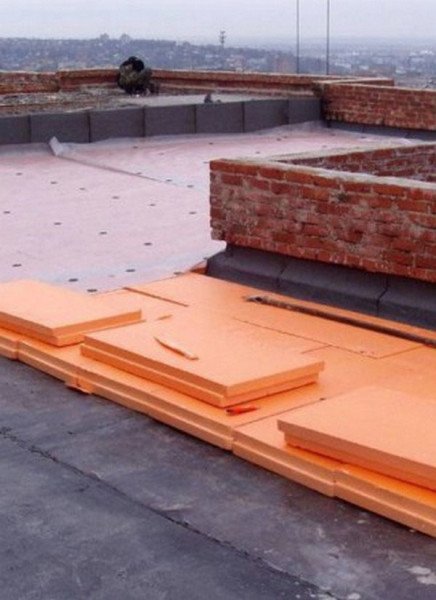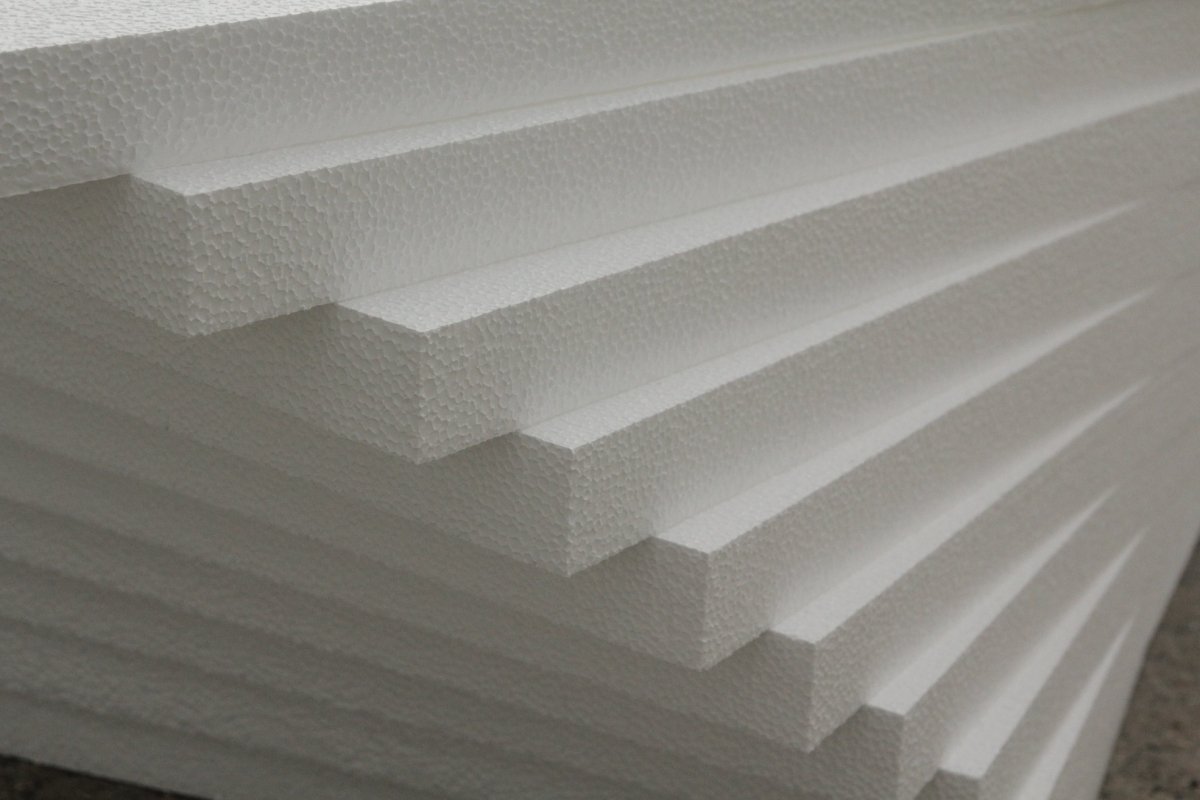To create a comfortable environment in rooms located in the under-roof space, you need to think about roof insulation. But what material to choose so that it conforms to modern technologies and does not lead to a heavier mass of the roof? One of the most popular in its category is polystyrene. In this article we will tell you how to insulate the roof with this material with your own hands.
Content
Material characteristics
In appearance, the foam is a white material. Air bubbles make up 98 percent of its base. They are enclosed in a polystyrene shell. The production method distinguishes between press and non-press material.
Polyfoam has several advantages. It is different:
- Light weight. This makes it easier to transport it, and also does not require reinforcing the load-bearing roof structures during installation.
- Environmental safety. The food industry is the area of application of foam. It is used in the manufacture of packaging products, and is also used in children's toys. The material is non-toxic and non-toxic. The foam does not smell, and working with it eliminates the formation of dust and skin irritations.
- Low coefficient of thermal conductivity. This is due to the air included in its composition, which has long proved to be a heater.
- Good soundproofing properties. With proper work with the material, roof insulation with its help eliminates the need for additional measures to improve wind protection.
- Long service life. Polyfoam is resistant to aging. Over time, its characteristics will not deteriorate. This also applies to the size of the plates. They do not change over the entire period of its use.
- High moisture resistance. This quality allows the use of the material in a humid environment. This will not affect its thermal insulation in any way.
- Biological resistance. On the surface of the foam eliminates the possibility of mold, rot, debate. A nutrient medium that can promote the growth and reproduction of microorganisms and bacteria is also absent - this is the main difference from other materials of a natural organic origin.
- Chemical resistant. It manifests itself in the property of the foam not to react to chemicals - for example, paint or glue. Polyfoam is protected from aggressive environments.
- High vapor permeability. This property allows you to prevent the accumulation of excess moisture on the inside of the roof, which is very important for wooden elements of the roofing cake. The roof “breathes” and the moisture evaporates.
- High heat resistance. Polyfoam can be used for roofing in various climatic conditions. It does not undergo changes with temperature differences.
- Resistance to stress. Compared to the popular mineral wool, polystyrene is able to withstand large short-term and long-term loads.
- Fire safety. The possibility of fire in contact with open flame is excluded. Thanks to special additives, the material will melt, showing good refractory properties.
- Convenience of installation. Polyfoam will not require the use of expensive tools when working. Its processing and cutting is not difficult. This can be done with an ordinary sharp knife.
The fragility of the material is its fragility.. Inaccurate handling of the foam may break, which will lead to the need to purchase additional products.In order to avoid damage to the material before starting work, it is better to order home delivery.
Foam plates are distinguished by density. Its ability to withstand loads depends on it. The following types of foam are available:
- Density is 15 kg. per 1 cubic meter (PSB15). Its thickness varies from 5 to 10 cm. Such plates are used for the installation of a pitched and attic roof, as well as for the ceiling. Due to its low density, such a material is not strong enough for high loads.
- Density 25 kg per 1 cubic meter (PSB25). It has the same thickness. It is used mainly for insulation of walls, as well as floors.
- With a density of 35 kg per 1 cubic meter (PSB35). It is also called extruded polystyrene foam. Designed for the installation of places often subjected to mechanical stress - a flat roof, floor and attic floor. It performs well in harsh climates.
- Polyfoam brand PSB-S-50 - the most dense in the entire line of material. It withstands mechanical stress. It is used for external insulation.
Installation instructions

Atthe laying of foam boards can be done on the roof of any design: whether it is an exploited flat or pitched roof. For work, auxiliary materials such as waterproofing, geotextiles and gravel will be needed.
Work stages
- First you need to calculate the need for material. Foam slabs should be laid over the entire roof area. It will be best to add several plates to the calculated quantity - just in case. Due to the fragility of the foam, it must be protected from mechanical stress.
- Before starting installation, the roof will have to be cleaned of the old backfill.
- It is important at the stage of preparation of the roofing cake to check all materials for defects. On the rafter system, the formation of rotting or traces of dampness is not allowed. If there are damaged elements, then they must be replaced with new ones. Damage by insects must not be allowed. Holes are also considered defects.
All wood structures must be treated with special fire-fighting chemical compounds and an antiseptic. Sometimes it will not be amiss to use reinforcing and disinfecting materials.
- On a flat or roof made of concrete blocks, check the surface for cracks, leaks. Defects can be eliminated by coating them with a cement-sand mixture. If there are leaks, then they are waterproofed.
- When installing thermal insulation on a pitched roof, it is necessary to ensure that the minimum slope is at least 25 degrees. This condition will ensure free flow of water from the roof and will create a reliable design.

- After that, a waterproofing layer is laid. It should also cover the entire roof area.
- Foam plates must be laid in such a way as to prevent the formation of voids. Lay it on a waterproofing layer. In this case, special attention should be paid to the places of combining the edges of the plates.
Fewer joints will provide better thermal insulation qualities.
- For better protection of the roof, it is necessary to provide in the roofing pie laying of a layer of hexotextile material. It contributes to the protection of plates from harmful or mechanical effects. Geotextiles are attached to the back of the rafters using wooden battens.
- Next, you will need to backfill with gravel or concrete with a fraction of 16/32 5 cm thick.
The thickness of the backfill is best calculated taking into account the strength of the wind.
- Foam boards must be secured with wooden battens or galvanized nails. The average thickness of the material suitable for insulation is 7 cm.
- A waterproofing film is laid on top of the insulation.
- If we are talking about the insulation of the attic, then from the inside, the foam plates are sheathed with plasterboard or lining.
External insulation

Sometimes it is required to insulate the roof from the outside. This method is often used in industrial construction and for residential areas in the city..
Work stages
- Initially, of course, it is necessary to calculate the need for material and purchase the required number of plates, adding a few additional ones to them. We need sheets with special quarters for docking.
- Before starting installation work, the roof is cleaned of debris and dust. You will also need to close up the holes with a solution, if, of course, they are.
- The roof is insulated with expanded polystyrene, sticking it to a surface covered with bitumen mastic. Sheets must be tightly joined in a quarter. Reliable insulation will be ensured only with a continuous coating of the surface.
- If necessary, you can stack the plates with a run. This will allow you to mount the material in several layers.
- Next, proceed to the installation of cement screed over the entire surface area.
- After drying, the screed will need to be further treated with a primer (bituminous mastic) in order to proceed with further roofing. This can be done by heating the mastic with a gas burner. The diesel fuel added to the solution will reduce the viscosity, which will provide a more comfortable application. For work, you can use ordinary household mops.
- The final stage of work will be linocrom flooring. It is laid in two layers. At the same time, the second will be supplemented with special topping, which will protect the roof from mechanical and climatic effects.





Marik
Polyfoam is certainly a good material, no one will argue, but still now so many interesting things have appeared on the market.
zzzz zzzzz
By the way, I did not insulate the roof in industrial construction. When he built his house, he did not spare money for insulation.